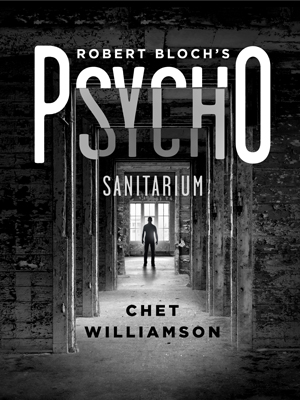
Robert Bloch (1917-1994) left a considerable body of work in the fields of crime, horror, and science fiction, but is best remembered for his psychological horror, Psycho (1959). Its protagonist, Norman Bates, was immortalised in Alfred Hitchcock’s film the following year. There were sequels to the original book and film, but nothing caught the public imagination in quite the same way.
Psycho ends with Bates, whose oedipal complex and split personality led to him to kill four people, locked away in a hospital for the criminally insane. Chet Williamson, himself a veteran crime and horror author, begins Psycho: Sanitarium just days after Bates’ arrival at the State Hospital, so it slots in after the first book and before Robert Bloch’s own sequel, which is set decades later.
Since arriving, Bates has been almost stuperose, mute and unable to look after himself and needing to be fed. His outward demeanour masks an internal battle between his two personalities, Norman and Mother. There is also conflict between his psychiatrists over how to treat him. Dr Goldberg, the senior doctor, believes he needs a course of electro-shock treatment but his junior, Dr Reed, believes a gentler course of therapy is best. If only Bates can be made to talk about his mother, then his split personality can be addressed.
Reed is given the chance to prove his new methods and enlists the help of nurse Marie Radcliffe. Reed and Radcliffe have confidence in modern psychiatry, but the majority of the staff believe the inmates should be treated as criminals rather than patients. However, Bates shows steady progress and is soon out of solitary and beginning to mix with other patients. The downside is that contact with others means he is tormented by sadistic attendant Myron Gunn and serial rapist Ronald Miller, who wants Bates to describe his murders in lurid detail.
These encounters send Bates back into his shell so Reed is delighted to be able to introduce him to his long lost twin Robert Newman. Newman knows about Bates’ crimes from the news and the background detail reported at the time of Bates’ trial led him to realise that Bates is his twin, separated at birth.
At first Bates is apprehensive about meeting Newman but soon their relationship grows and Bates begins to banish Mother. However, Newman’s interest in Bates might not be as innocent as he maintains. He talks about his own daily frustrations and his admiration for Bates’ ability to deal with his problems so conclusively. Shortly after this the rapist Miller goes missing – has he escaped or been murdered?
Much like the original book, Psycho: Sanitarium straddles the crime and horror genres. As more people are killed a common link between them arises – all in some fashion aim to hurt Bates. Williamson keeps the identity of the murderer a mystery until the final chapters, and certainly had me looking in the wrong direction. The twist has a delightful outré pulpy feel which is in keeping with the novel’s inspiration and with its general tone. Williamson is adept at adding pulp styling, writing outlandish plot points as the inmates start to believe that a supernatural agent is behind the disappearances, and giving us access to the diary of a previous hospital superintendent who believed in particularly cruel and unusual treatments.
I am a sucker for this kind of novel, but it does require the suspension of disbelief. It certainly stands out in tone from most other contemporary crime fiction, though some readers might find Psycho: Sanitarium implausible or even unsophisticated. There is an emphasis on atmosphere and sensationalism over characterisation. While not for everyone, and after a fairly slow start, it’s something you’ll eat up if you enjoy a bit of pulpy horror.
Read our interview with the author here.
Canelo
Print/Kindle/iBook
£1.99
CFL Rating: 3 Stars







